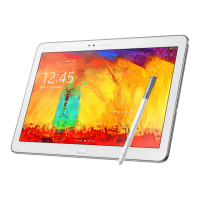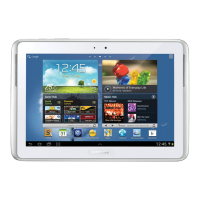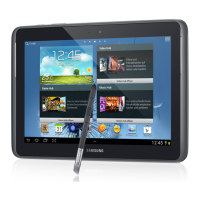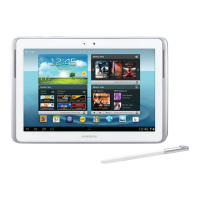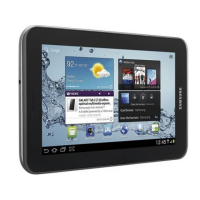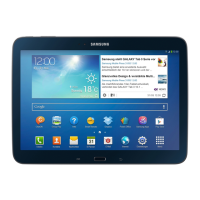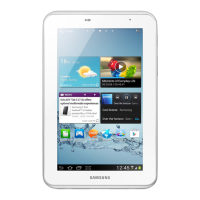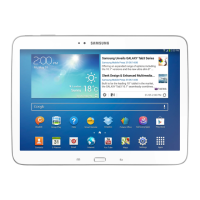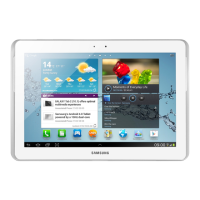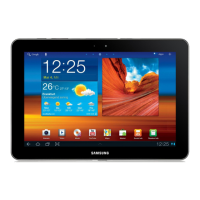Do you have a question about the Samsung GT-N5110 and is the answer not in the manual?
Overview of device physical components and ports.
Explains the function of each physical button on the device.
Details the S Pen's parts and basic functionality.
Lists items included in the product box.
Instructions on how to charge the device's battery.
Guide on how to insert and use a memory card.
Steps for safely removing the memory card.
Process to format the memory card for device compatibility.
Procedures for powering the device on and off.
Guidance on proper device handling to avoid signal issues.
Methods to secure and access the device.
How to control the device's sound volume levels.
Various ways to set the device to silent or vibrate.
Explains common status icons displayed on the screen.
Guidelines for interacting with the touch screen interface.
Describes various touch gestures like tap, drag, pinch.
Explains device control using physical motions and gestures.
Feature that launches apps based on user actions.
How to enable and use the split-screen multitasking feature.
Detailed guide on using the S Pen for various functions.
Using gesture commands for quick access to features.
Managing and viewing device notifications and status updates.
Customizing and managing the device's main interface.
Adding and using small applications on the Home screen.
How to open, manage, and uninstall applications.
Methods for inputting text using the keyboard or voice.
Steps to join and manage Wi-Fi connections.
Creating and managing Google and Samsung accounts.
Moving data between the device and a computer.
Setting up screen locks and other security features.
Procedures for updating the device's software.
Managing contact information, phone numbers, and email addresses.
Methods for syncing and transferring contact data.
Adding and managing frequently contacted people.
Organizing contacts into groups for easier management.
Creating and sharing personal contact information.
Sending, receiving, and managing email messages.
Using the Gmail service on the device.
Chatting with others using Google Talk.
Using Google's social networking service.
Instant messaging service integrated with Google+.
Cross-device chat application.
Browsing the internet and accessing web pages.
Reviewing and clearing browsing history.
Using the Google Chrome browser for web access.
Connecting and exchanging data wirelessly with other devices.
Sharing device screen content to a large screen via dongle.
Playing and sending media content across devices.
Sharing screens and media with multiple devices on Wi-Fi.
Using the device to control a TV.
Listening to music files on the device.
Taking photos and recording videos with the device.
Detailed guide on capturing still images.
Applying predefined settings for specific photo scenarios.
Selecting different modes for photo capture like Panorama.
Instructions for recording video content.
Selecting video capture modes and settings.
Adjusting various camera settings and options.
Viewing, editing, and managing photos and videos.
Applying various edits to photos like cropping and rotating.
Application for applying artistic effects and frames to images.
Playing video files on the device.
Watching videos from the YouTube platform.
Accessing personalized news and magazine content.
Downloading and purchasing applications and games.
Accessing Samsung's dedicated application store.
Accessing and downloading games.
Playing and purchasing music from the Music Hub service.
Reading and downloading e-book files.
Watching, renting, and downloading movies and TV shows.
Listening to music from the device or Google cloud.
Reading and downloading digital magazines.
Downloading and reading book files.
Accessing and purchasing video content.
Accessing educational and learning materials.
Creating notes with multimedia and voice recordings.
Choosing from various templates for note creation.
Tools and functions for writing and editing notes.
Application for creating and managing notes.
Managing events, tasks, and schedules.
Adding new events and tasks to the planner.
Editing documents, spreadsheets, and presentations.
Saving and sharing files using cloud storage.
Setting wake-up calls and event alarms.
Configuring alarm times, repeat days, and snooze options.
Checking the current time in different global locations.
Performing simple and complex calculations.
Controlling the device using voice commands.
Searching the internet and device content.
Searching for information using voice commands.
Accessing and managing files stored on the device.
Viewing files downloaded from the internet or apps.
Pinpointing locations, searching places, and getting directions.
Finding addresses, nearby places, and detailed location info.
Planning routes using different travel methods.
Searching for nearby points of interest like restaurants.
Guiding the user to a destination with turn-by-turn directions.
Overview of device configuration and account management.
Connecting to and managing Wi-Fi networks.
Direct wireless connection between devices via Wi-Fi.
Exchanging data wirelessly over short distances.
Monitoring and managing mobile data consumption.
Customizing connections and device settings.
Disabling all wireless functions for restricted environments.
Managing media sharing and access with other devices.
Sharing device display wirelessly to a TV.
Selecting between basic or easy modes for the home screen.
Configuring which notifications are blocked.
Adjusting device volume, vibration, and notification sounds.
Customizing wallpaper, brightness, and screen timeout.
Managing device memory and formatting memory cards.
Optimizing battery usage by adjusting device settings.
Viewing information on battery power consumption.
Viewing and managing installed applications.
Managing permissions for location-based services.
Securing the device with screen lock options and shortcuts.
Encrypting data, managing credentials, and remote controls.
Changing display language and text input methods.
Customizing keyboard settings and input features.
Configuring voice input and recognition settings.
Managing data syncing with cloud storage services.
Backing up data and resetting device settings to factory defaults.
Enabling and configuring motion-based device controls.
Changing settings related to the S Pen functionality.
Configuring settings for connected accessories like docks.
Setting and managing the device's date and time.
Adjusting settings for users with disabilities.
Advanced settings for application development.
Viewing device information and software version.
Resolving issues with network connectivity and service errors.
Troubleshooting touch screen responsiveness problems.
Steps to resolve device freezing or critical errors.
Addressing low battery warnings and issues.
Diagnosing and fixing battery charging or power-off issues.
Understanding and managing device overheating.
Resolving camera application errors related to memory or battery.
Troubleshooting issues with playing music files.
Resolving problems finding Bluetooth devices.
Fixing issues with computer connection via USB.
Information about a minor physical characteristic of the device case.
| Model | GT-N5110 |
|---|---|
| Category | Tablet |
| Processor | Quad-core 1.6 GHz Cortex-A9 |
| Chipset | Exynos 4412 Quad |
| GPU | Mali-400MP4 |
| RAM | 2 GB |
| Internal Storage | 16/32 GB |
| Expandable Storage | microSD, up to 64 GB |
| Front Camera | 1.3 MP |
| Battery | Non-removable Li-Ion 4600 mAh battery |
| Colors | White |
| Sensors | Accelerometer, gyro, compass |
| Display | 8.0 inches |
| Main Camera | 5 MP |
| Operating System | Android 4.1.2 (Jelly Bean) |
| Dimensions | 7.95 mm |
| Weight | 338 g |
| Connectivity | Wi-Fi 802.11 a/b/g/n, dual-band, Wi-Fi Direct, hotspot |
